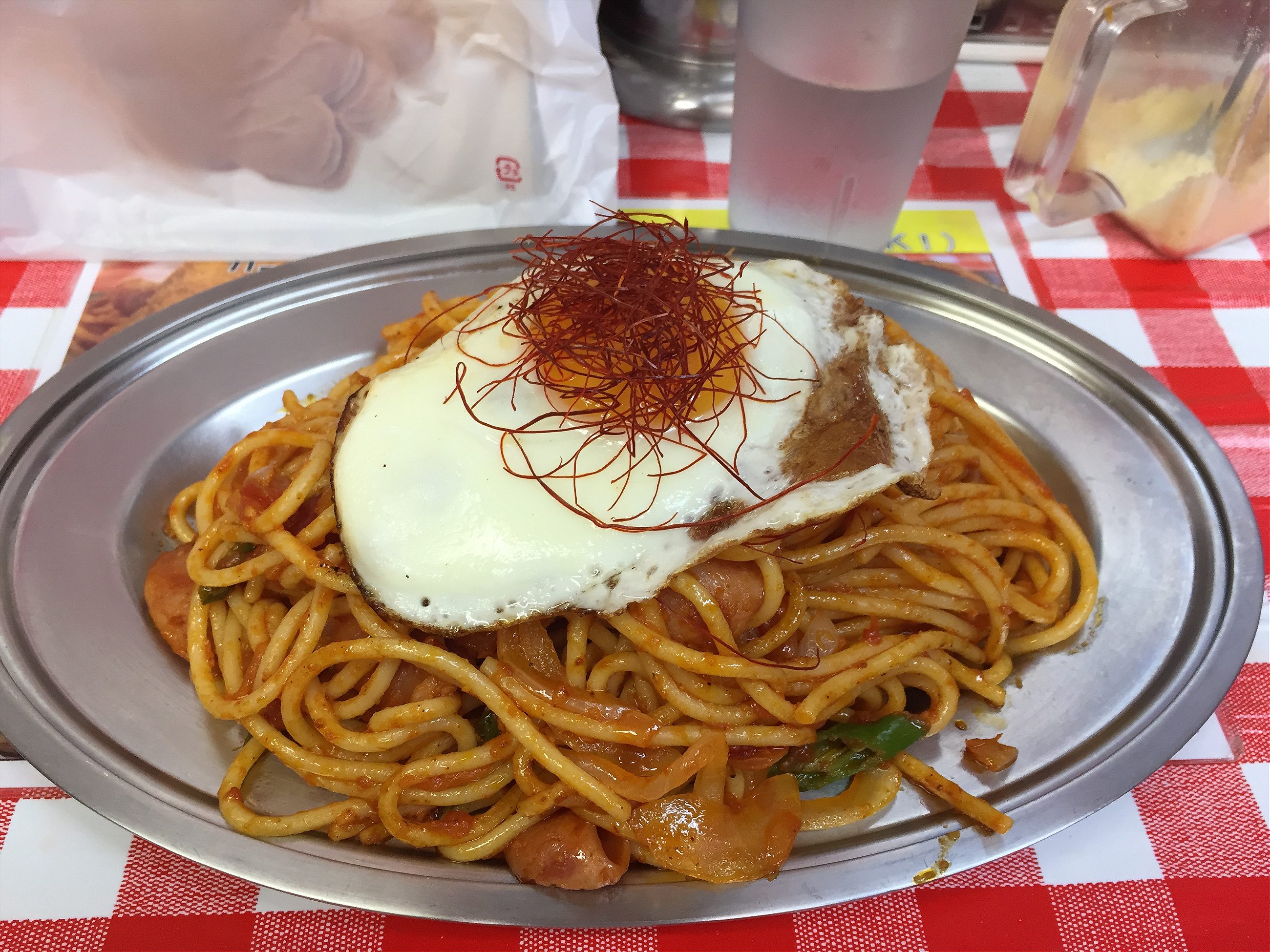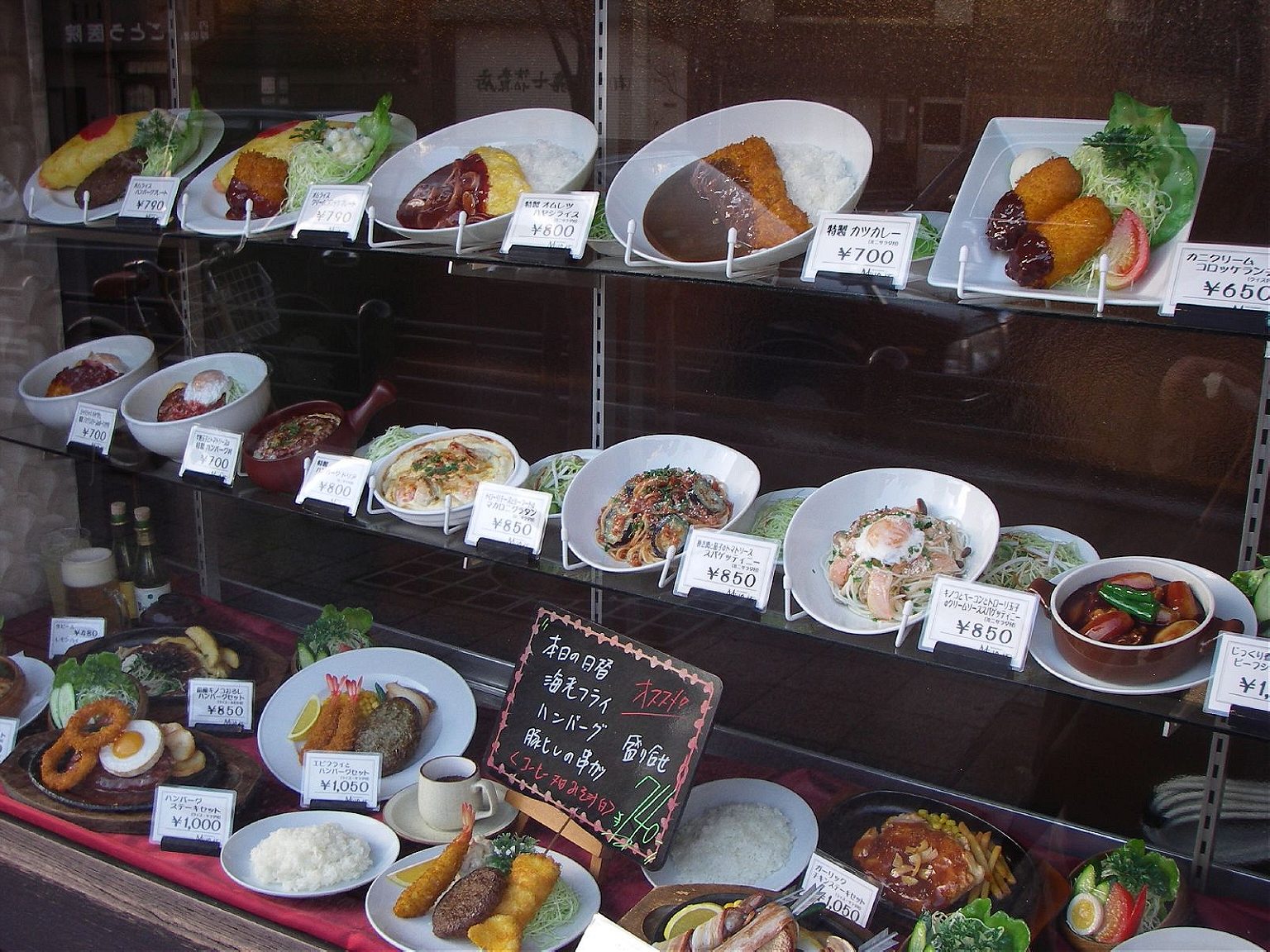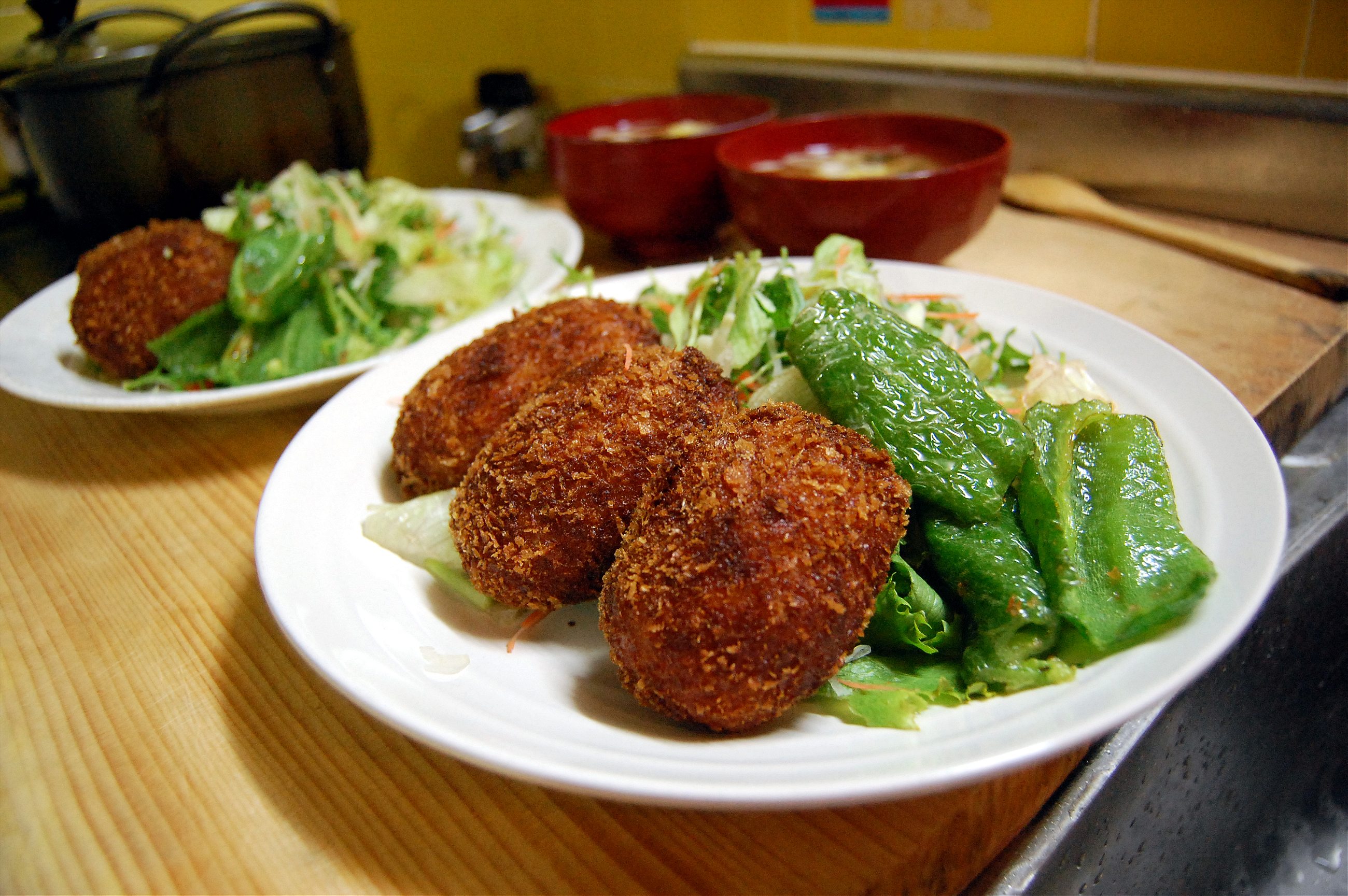Japan’s homegrown foreign cuisine—or is it foreign homegrown cuisine?—is finally getting its due as a perfectly indigenous and brilliant food in its own right.
The interior of a Japanese Denny’s is like every chain restaurant in the world. Leatherette booths line the walls. Muzak plays softly overhead. A happy, warm fluorescence fuels the place around the clock. The clearest sign that you’re not in the United States is the sound of the staff calling irrashaimase (or ‘welcome’) and arigato gozaimasu (‘thank you’) to diners as they come and go.
And then there’s the menu.
Everything is tailored to suit the Japanese palate: excess being uncommon at a Japanese table, a Denny’s breakfast here includes just a single rasher of bacon sitting prettily next to a perfect sunny-side up egg, served with garden salad on the side (the double portion is sensibly advised for two). A Japanese breakfast option includes a bowl of rice, miso soup and natto (fermented soy beans) paired with salmon or, if you prefer, bacon and eggs. There are no sloppy joes or Grand Slams. Instead, there’s spaghetti naporitan (soft pasta stir-fried with ketchup and vegetables), hanbagu (usually translated as ‘burger steak’), and omu-rice (an almost-portmanteau for omelette over rice). An American chain in the heart of Japan serving food from neither here nor there: I’d stumbled into the epitome of yoshoku.

Some days earlier I found myself in a curry house in Shinjuku, looking down into a piping hot plate of kare raisu: a thick gravy pooled luxuriantly over a pillow of short-grain rice and crisp tonkatsu (breaded pork cutlet). The spices were low-key and mildly sweet, a world away from the unsubtle heat of the British-Indian curries that originally inspired the dish back in the 19th century, when British naval officers first came ashore in Japan. The dish in front of me—its name a local inflection of the English words curry rice—is prototypical yoshoku, a term used to describe Japanese foods adapted from foreign cuisines, as opposed to traditional Japanese food, called washoku.
Foreign foods first appeared on Japanese plates during a period known as the Meiji Restoration, which began in 1868, a decade after the previously isolationist island nation opened its doors, albeit reluctantly, to the first American “Black Ships.” By then, consumption of meat had been illegal in Japan for centuries. The introduction of Buddhist beliefs by Korean missionaries in 552 A.D culminated in an imperial edict during the rule of Emperor Tenmu that prohibited the killing and consumption of domestic livestock, considered very close to humans (wild animals, seafood, and eggs were exempt from the prohibition).
Through the coming centuries, the idea that eating meat was unclean gained wider currency. According to the Heian Period’s (794-1185) Engishiki, a historical text on Japanese laws and customs, someone who ate the meat of a domestic animal had to fast for three days. This escalated during the Kamakura Period (1185-1333), with an order that demanded a fast of one hundred days for anyone who disobeyed the prohibition, and a fast of 21 days for anyone who so much as shared a table with someone eating meat.
As time went on, these laws took on more complex political and ideological shadings. Converts under the influence of Jesuit missionaries, who first arrived in the 16th century, often disregarded the meat prohibition, and by the end of that century some members of the Japanese nobility had started experimenting with the practice of eating livestock. Peasants living in poorer agricultural areas supplemented their diets with wild boar and venison and some samurai continued to eat beef for its purported medicinal qualities. Yet the general cultural aversion to cattle slaughter persisted strongly enough that it was used as one of the primary justifications for expelling the Jesuits in the early 17th century. Some of Japan’s most far-reaching animal protection laws were passed at the end of the 17th century under the Dog Shogun (1680-1709), so called for his famous ‘Laws of Compassion,’ which shielded dogs, sick cattle, and horses.
1200 years after the first meat prohibitions became law, they were suddenly lifted
Under the Meiji Restoration, livestock consumption, previously seen as a vice of the uncivilized Europeans, became a key marker of European modernity; 1200 years after the first meat prohibitions became law, they were suddenly lifted. In 1872, Emperor Meiji brought in the New Year by eating meat and people gradually followed suit. “Over just five years [after the meat ban was lifted], beef consumption in Tokyo shot up more than thirteen times,” writes Marta Zaraska in her book Meathooked: The History and Science of Our 2.5 Million Year Obsession with Meat. Even still, as recently as 1939, the average yearly consumption of meat for every Japanese person was just 0.1 ounce per day.
The introduction of meat in the Meiji period was also, to a large extent, the introduction of yoshoku. In the early decades of the Restoration, Western ingredients remained difficult to come by, so cooks had to adapt unusual foreign foods using the ingredients at hand, adjusting those dishes to Japanese tastes. As the 20th century proceeded, that process gained momentum. Following World War II, Zaraska notes, “the American occupation […] gave another powerful boost to the hunger for meat, as the Japanese observed the war victors stuffing themselves with hamburgers, steaks, and bacon.”
That hunger reached unprecedented heights during the economic boom of the 1970s and 80s as the Japanese market became newly attractive to foreign restaurateurs. At the time, yoshoku was the only version of Western food known to locals, but the arrival of authentic European cuisine fomented a new period of experimentation. Western media had, by that point, fully infiltrated the Japanese cultural imagination, enough so that, when businessman Den Fujita opened the first McDonald’s in Japan he was reported to have said that the Japanese were poorly built because they ate rice. McDonald’s, he believed, would change that. “After eating hamburgers for a thousand years,” he said, “the Japanese will even have blonde hair.” Fast forward forty years, and, though the Japanese aren’t blonde, they are eating more fast food than ever, including yoshoku items like the Chicken Tatsuta at McDonald’s—a ginger- and soy-flavored chicken patty served with lettuce and wasabi tartar sauce on a steamed bun—and the Red Samurai at Burger King, served with a miso and pepper hot sauce.

Japanese food today would be unrecognizable to the country’s pre-Meiji denizens. Trade data shows that pork and beef imports have increased exponentially in the last decade alone, even as seafood imports steadily decline. February 9 has been declared an unofficial National Meat Day, with supermarkets and restaurants offering discounts and “All-You-Can-Eat” deals. Because the Japanese words for ‘two’ (ni) and ‘nine’ (kyuu) resemble the word for ‘meat’ (niku), some people use the twenty-ninth of each month as a day to indulge in an extra bout of carnivory. Obesity rates are, unsurprisingly, on the rise.
Yoshoku has also become ubiquitous. You’ll find it in countless yoshokuyas, on Japanese cooking shows, in mainstream magazines, and even in people’s homes. Walk through Tokyo’s downtown Ginza district, and you’ll be surrounded by shops and food carts selling bifusuteki (beef steak), French-inspired korokke (croquettes), tonkatsu rice and chicken nanban (fried chicken). Convenience stores stock mikkusu sando, an assortment of sandwiches made with fillings like egg salad and ham, and ready-made naporitan spaghetti.
Many yoshoku dishes are eaten with a knife and fork as opposed to chopsticks, are served with a choice of rice or bread, or come with an array of Western sauces like Worcestershire, mayonnaise, and ketchup. But despite these obvious markers of western provenance, these dishes are now essential to Japanese cuisine, as the chef at the curry house, Yoshiyuki Satou, told me that day. “Yoshoku is Japanese food. When you think of food like kare and tonkatsu, which country do you think of immediately?” he asked rhetorically. “They may have been inspired by non-Japanese cuisine, but we’ve made them fully Japanese.”

The following week, I went to sample a broader variety of yoshoku dishes at a restaurant called Azabu Shokudo in Tokyo’s Minato ward.
“This thing called yoshoku is hard to grasp from a foreigner’s perspective. It’s neither here nor there, neither traditional Japanese cuisine nor Italian nor French,” said the restaurant’s chef, Konosuke Sugino, as I surveyed the scrumptious spread on the table in front of me. “Its roots come from the images of Westerners that Japanese people have vaguely acquired.”
On the table were dishes of naporitan spaghetti, a breaded and deep-fried hamburger patty known as menchi katsu, omu-rice, and doria, a rice- and seafood-based gratin doused in cheese and bechamel. One of my dining companions, Ryo, giggled as he took a first bite of doria. “It’s been a while since I’ve had this,” he said. “I remember growing up and, when I got good grades, my parents treating me to an okosama lunch”—a type of kid’s lunch popular in department store restaurants—“The doria would come with a little French flag on top!”
Sugino nodded. “It’s a surprise for a non-Japanese, I think, but Japanese history and yoshoku are so closely linked. One cannot exist without the other,” he said. “Nowadays, everyone from the young to the old in Japan has had yoshoku.”
In the last decade, that transformation has been mimicked outside Japan, as well. When Michelin published its first Tokyo guide at the end of 2007, it awarded more stars in that city than any other on earth, cementing the city’s reputation as the greatest food destination on earth, and yet of the 150 establishments featured, not one served yoshoku. However, in the press release for Michelin’s tenth Tokyo guide, released earlier this year, international director for Michelin Guides, Michael Ellis, cites yoshoku alongside ramen as “one of those cuisines whose origins were from outside Japan but which have now become Washoku after evolving in Japan.” Sugino told me that he’d had hanbagu and omu-rice in New York, kare in Melbourne, and korokke in Vancouver. I told him excitedly about my favourite kare joint where I live in Adelaide. He smiled proudly and said, “Chicken karaage is now everywhere in the world, too.”
Though we were already stuffed, Sugino served up one last yoshoku staple, a plate of hanbaguu. The flat, round puck of spiced ground beef mixed with finely chopped onion, egg, and breadcrumbs arrived in a shimmer of demi-glace, garnished with a shower of grated daikon. The only iteration of Salisbury steak not yet relegated to the microwave dinner tray, Sugino’s hanbagu was an American classic with an unmistakable Japanese flourish.
I asked Sugino if he considered yoshoku ‘authentic.’ He heaved an emphatic sigh. “Nothing belongs to anyone anymore. Everyone borrows, re-invents, and experiments. Yoshoku is like j-rock,” he said, referring to Japanese rock music. “Ours, but born from the beasts of the outside world.”